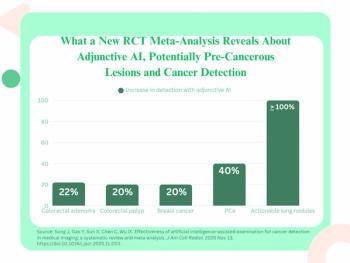
- Diagnostic Imaging Vol 31 No 4
- Volume 31
- Issue 4
Return to core principlesin hospital negotiations
It is not news to anyone that weare going through some verydifficult economic times.Radiology groups are feeling theeconomic squeeze just like othersmall businesses.
It is not news to anyone that we are going through some very difficult economic times. Radiology groups are feeling the economic squeeze just like other small businesses.
The costs of operating a radiology practice are increasing at the same time that radiology groups face dwindling possibilities for increasing their revenues. Decreased reimbursement and fewer avenues to participate in new technical component ventures characterize the current radiology market.
In these tough times, those radiology groups that are hospitalbased are focusing on their important strategic relationships with their hospitals. The professional services agreement that a radiology group has with its principal hospital or hospitals, consequently, has become more important than ever.
Scores of important business and legal issues confront a radiology group as it begins negotiating a new agreement with its hospital. But, for my money, there are three core issues that make for a successful- or less than successful-radiology hospital contract: the scope of exclusivity, the pervasiveness of any noncompete agreements, and the presence or abscence of opportunity for compensation beyond payment for professional services.
EROSION OF EXCLUSIVITY
At one time in my career, exclusivity in most hospital contracts was meaningful. Chatter about turf erosion has always existed, but in the last five years, I've seen a cascading erosion of exclusivity.
The typical hospital administrator's attitude is, “Sure, this contract is exclusive. No other radiologists can apply for privileges to do what you do, can they?” It's an understatement to say that administrators are less willing to resist giving radiology privileges to cardiologists, oncologists, vascular surgeons, and numerous other nonradiologists who can bring their patients to the hospital and fill its beds.
Only a rare hospital administrator understands, or will admit to understanding, the impact of lack of exclusivity on the group's ability to deliver quality subspecialty services seven days a week, 24 hours a day, 365 days a year. It is the grant of exclusivity that creates the economic and clinical environment in which a radiology group can thrive while at the same time assuring a hospital the availability of subspecialty coverage for the indigent patient at 3 a.m.
The most pernicious example of loss of exclusivity and its adverse impact on the delivery of services is in interventional radiology. Sad to say, I am seeing one quality IR program after another disintegrate when hospitals embrace so-called multidisciplinary angiography programs. Vascular surgeons and cardiologists gain access to the angio suite during the day, with interventional radiologists left increasingly with a larger indigent patient load and total (and unappreciated) responsibility for evening and weekend call.
All of us, as human beings, react to our surroundings in our jobs. We tend to gravitate to those positions that not only satisfy us economically but also reward our sense of well-being. My observation is that few interventional radiologists remain content to stay with a radiology group that does not allow them to regularly engage in the quality and challenging work for which they are trained and relegates them to carrying a beeper several nights a week.
If someone has an example of a successful multidisciplinary vascular/ interventional program anywhere in the country, I hope you will bring it to my attention. I have yet to see one that was not mostly a failure. Even those groups that are compensated for their IR call (or that have the nonradiologists share some of the call) sometimes have difficulty delivering the level of service the hospital enjoyed prior to the “new and improved” multidisciplinary approach to providing angiography services.
NONCOMPETES PROLIFERATE
At the same time the notion of exclusivity has been eroding, many hospitals have become even more ferocious in seeking ever-more restrictive covenants not to compete. A noncompete agreement can relate to the provision of professional component services, technical component services, or both. From the radiologist's perspective, the best hospital contract allows a radiology group to provide its professional component services anywhere in the geographic area.
There is an ample rationale for allowing radiologists to provide their services elsewhere, even to the fiercest competitors of the hospital. The astute hospital administrator will recognize the value of allowing radiology groups to provide their services throughout the community because that radiology group will have the resources to bring the full panoply of subspecialty expertise to that hospital's patients and medical staff.
My favorite anecdote dealing with radiology noncompetes for professional services involves a dispute in Fort Worth, TX, that ended up on the front page of The Wall Street Journal more than a decade ago. A new hospital administrator in town tried to lay down the law to his contracted radiology group, to command that a subset of the group must secede from the main group and provide services only to his hospital. He simply would not permit “his” radiology group to provide services to his competitors. Horror the thought!
Happily, the radiology group fought back and successfully made the case that it could recruit and retain its diverse subspecialty radiology services only if it had the ability to deliver those services across the region. The group gained the support of the medical staff, the local county medical society, and even the state legislature. If only all such noncompetition negotiations ended so successfully.
Of course, the principal focus of noncompete agreements these days relates to technical component services. Many radiology groups may be willing to trade the security of having a “good” contract with decent exclusivity for some restrictions on the ability to actually compete with the hospital technical component investments. Nevertheless, the technical component noncompete discussion can open the door to fruitful conversations about potential joint ventures. The Deficit Reduction Act and other cutbacks in reimbursement have made joint ventures a much less frequently discussed subject these days.
It should be noted that hospitals don't mind pushing the boundaries of enforceability for noncompetes these days. I'm in the midst of negotiating a contract for one of the country's largest and finest radiology groups. The hospital proposes to include the local jurisdictions in the noncompete, but it goes much further. It has listed every conceivable adjoining county as being part of the noncompete region, even where the hospital has no presence. The radiology group is proscribed against ever competing in those areas should the hospital ever decide to erect a facility in those areas; an amazing overreach, in my opinion.
Two final words on noncompetes: First, I strongly recommend that a group avoid “tailing” noncompetes (i.e., those that remain effective even after a professional services agreement is terminated or expires). Second, I have a different view regarding noncompetes in radiology group employment contracts. Radiology groups should, in their own intragroup contracts, have strong tailing noncompetes. Without such noncompetes, the hospital can cast an incumbent group aside with a simple termination notice letter.
A radiology group should position itself to require the hospital to deal with it as a single integrated economic unit. The radiology group with a large number of radiologists who are regulated by their own noncompete is harder to replace than the group that can be terminated when the hospital knows it can cherry-pick a sizable portion of the former group to join the new radiology group hand-selected by the hospital to replace them.
COMPENSATION
The overwhelming majority of radiology groups still look to the revenue generated by separate billing for their professional services as their sole source of compensation for the services they provide at hospitals. It is becoming more common, and certainly more appropriate, however, for hospitals to provide compensation in one form or another to a radiology group.
Particularly because of the erosion of exclusivity discussed above, hospitals are going to be able to attract and retain the best and brightest radiologists only if they find ways to supplement these radiologists' income payments through medical director fees, subsidies for teleradiology coverage, and bonuses in the form of incentive compensation or other types of performance bonuses.
Financial arrangements between radiology groups and tax exempt, notfor- profit hospitals are going to be constrained by notions of fair market value. One good source for fair market value compensation is the Medical Group Management Association Annual Physician Compensation and Production Survey. The 2007 survey supports a per-hour compensation rate for medical director services at $273 when the group is in the 75th percentile range.
It is appropriate and customary for radiologists to be paid for services provided to hospitals. In fact, CMS, in its Medicare Billing Rules at 42 CFR 415.120, contemplates that hospitals should pay radiologists for services they provide to the hospital. The Office of the Inspector General has opined on this issue as well, citing the need for payments to be made at no less than fair market value to hospital-based radiologists or risk running afoul of the antikickback statute.
In short, in these tough economic times, radiologists who work diligently on their hospital relationship are making a prudent investment in their future security. The issues are not easy, but progress can be made by focusing on core principles when negotiating a hospital contract.
Articles in this issue
over 16 years ago
Dismal economy now hidesprosperity just around the bendover 16 years ago
Serial mummy scanscapture CT advancesover 16 years ago
Apple hypes iPhone radiology applicationover 16 years ago
FSE-Cube earns praise forquality 3T knee MR imagingover 16 years ago
ACR, ARRS linkup joinseducation, political goalsover 16 years ago
Radiation dose fears colorcoronary CTA guidelinesover 16 years ago
Heterotropic Ossificationover 16 years ago
Inquiry concludes first-year residents not ready for callover 16 years ago
Pericardial fat predicts riskof coronary artery diseaseover 16 years ago
Private imaging facilitiesgrew at hospitals' expenseNewsletter
Stay at the forefront of radiology with the Diagnostic Imaging newsletter, delivering the latest news, clinical insights, and imaging advancements for today’s radiologists.



























